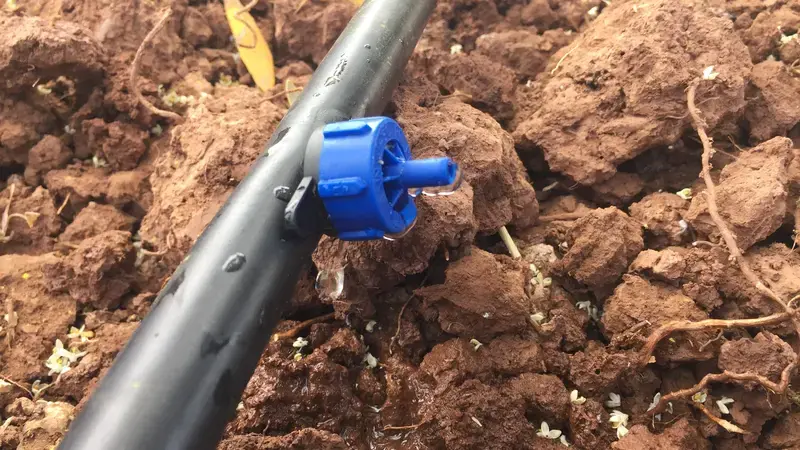Ultra-Low-Energy Drip Irrigation helps small farmers save water, energy, and money!

The biggest impediment for the adoption of drip irrigation by farmers is a lack of access to electricity and insufficient capital to invest in alternate power sources. Therefore, ICARDA is conducting research in Morocco, a country that is significantly dependent on agriculture and is suffering from water stress issues, with the goal of introducing a drip-irrigation system that demands much less energy than the conventional drip irrigation system for its operation.
Most small farmers in Morocco are off-grid and utilize diesel generators or solar energy for their power needs, which makes drip irrigation costly for them. For example, a solar system alone can make up to 80% of a drip irrigation system’s total capital cost for a farmer. MIT, Massachusetts Institute of Technology, has developed a new online PC (pressure-compensating) drip emitter that lowers activation pressure by 83%, operating at ~1/7 the pressure of conventional drip emitters. These new ultra-low energy emitters use only 15 kPa (0.15 bar) activation pressure, compared to conventional commercial emitters that utilize minimum pressures of 50–100 kPa (0.5–1.0 bar). Use of these low energy drip emitters could result in a 22-31% decrease in the capital costs of a drip irrigation system due to smaller pumps and less operating energy costs.
The Green Morocco Plan was launched in 2008 to promote the modernization and growth of national agriculture as
well as increase the income of national farmers. The Green Morocco Plan has made it a national goal that half of Morocco’s irrigated area becomes drip-irrigated by 2022 to reduce water waste in agriculture. Only 10% of Moroccan irrigated land is currently using drip irrigation, so the Moroccan government is encouraging small farmers to adopt drip irrigation through 100% subsidies.
Research on ultra-low energy emitters
A joint ICARDA-MIT project was initiated in Morocco in 2016. ICARDA, through local cooperation with the national
Moroccan agricultural research institute, INRA (Institut National de la Recherche Agronomique) has three research sites in Morocco, ½ hectare plots of olives, citrus, pomegranate, beans, and potatoes, spread between Beni Mellal, Marakech, and Agadir. The new ultra-low energy online emitters were used on crops in trial plots next to control plots with conventional emitters to compare the results. Throughout the years of 2016-2019, two things have been compared by this project: quantity of energy used and water distribution uniformity with the ultra-low energy emitters vs. conventional emitters.
The results have shown a 46-69% decrease in hydraulic energy used per unit volume of water delivered by the ultra-low energy emitters. Industry standards of water distribution uniformity have been successfully maintained, with the ultra-low energy emitters showing uniformities of 81–91%, compared to 87–96% for commercial emitters.
The benefits of the new technology introduced by ICARDA have been lauded by responsible figures in Moroccan agriculture.
In addition to ultra-low energy online emitters, developing ultra-low energy inline emitters, which can be used with vegetables and cash crops, would be of further interest to the Green Morocco Plan, as they would help increase the income of national farmers.
This joint ICARDA-MIT project is ongoing and currently focused on optimizing this ultra-low energy drip technology in Morocco. New inline ultra-low energy emitters with a 68% lower activation pressure than conventional inline emitters are now being field validated by ICARDA in Morocco with vegetables and cash crops.
Saving water, energy, labor, time and money
In addition, a fully off-grid solar-powered drip system is currently monitored on the field, using minimal solar power (fewer solar panels and smaller pumps = lesser costs!). Work is also being done towards the inclusion of evapotranspiration (ET) sensors into this solar powered, ultra-low energy, drip irrigation system. These evapotranspiration upgrades will be part of the already-existent pump controllers and will incur minimal to NO additional cost. Studies have shown that taking evapotranspiration into account could save up to 40% of irrigation water, and yield could also be increased by up to 46-56%. Thus, when irrigation times are controlled according to evapotranspiration, the utilization of water and energy by this optimized drip irrigation system will be further decreased.
These ultra-low energy emitters will finally facilitate drip irrigation adoption on a large scale in Morocco and
throughout the MENA regions that have a pressing need for water-saving irrigation strategies but are hindered by energy limitations. High energy costs and lack of access to electricity will no longer be an obstacle, as our ultra-low energy emitters are expected to reduce 46-69% of the energy required. This would enable solar power usage and make drip irrigation an affordable reality for off-grid small farmers. As a result of this ultra-low energy optimized drip irrigation system, these regions’ farmers will now benefit from drip irrigation in the form of significant water savings, higher crop yields, higher quality produce, and less labor; with the bonus of up to 69% less energy costs!
For more information, please contact Vinay Nangia, Agricultural Hydrologist at ICARDA: [email protected]
Upcoming events
16-20 March 2020. Marrakech, Morocco. 5th African Regional Conference of the ICID, ICARDA is organizing a technical tour to solar drip irrigation project site





